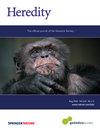The genetic basis of a colorful signal: the polymorphic dewlap of the slender anole (Anolis apletophallus)
IF 3.9
2区 生物学
Q2 ECOLOGY
引用次数: 0
Abstract
Organisms often use colorful morphological traits to communicate with members of their own or other species. While “colorful signaling” systems exemplify well-known examples of the evolution of phenotypic diversity, the genetic basis of most of these traits remains unknown. Male lizards of the genus Anolis possess a colorful throat fan, or “dewlap”, that is flashed during social displays. These displays have been extensively studied in the context of their role in the adaptive radiation of the genus. In contrast, the genetic basis of the Anolis dewlap has received relatively little attention. Here, we studied the dewlap of the slender anole (Anolis apletophallus) which exhibits a dewlap polymorphism: males have either an entirely orange dewlap (“solid” morph) or a white dewlap with a basal orange spot (“bicolor” morph). To understand the inheritance of this polymorphism, we conducted 99 crosses between individuals from populations that were fixed for one morph (single/fixed/monomorphic) or contained both morphs (mixed/polymorphic). Next, we investigated the genetic architecture of this trait using a pooled population sequencing (Pool-seq) experiment. Our findings indicate that the slender anole dewlap polymorphism is best explained as an autosomal, single-locus, Mendelian trait with the solid morph allele dominant to the bicolor morph allele. Our outlier analysis of the Pool-seq data identified a region strongly associated with this trait and within this region we identified a promising candidate locus—the transcription factor single-minded 1 (SIM1)—that may underly the dewlap polymorphism.

一种彩色信号的遗传基础:细长的变色蛇(Anolis apletophallus)的多态脱壳。
生物经常使用丰富多彩的形态特征来与自己或其他物种的成员交流。虽然“彩色信号”系统是众所周知的表型多样性进化的例子,但大多数这些特征的遗传基础仍然未知。雄性蜥蜴属的蜥蜴有一个彩色的喉扇,或“dewlap”,在社会展示时闪烁。这些显示已被广泛研究的背景下,他们在适应辐射属的作用。相比之下,Anolis dewlap的遗传基础得到的关注相对较少。在这里,我们研究了细长的斑点斑马鱼(Anolis apletophallus)的斑马鱼,它表现出一种斑马鱼的多态性:雄性的斑马鱼要么有一个完全橙色的斑马鱼(“纯色”形态),要么有一个底部有橙色斑点的白色斑马鱼(“双色”形态)。为了了解这种多态性的遗传,我们在固定为一种形态(单一/固定/单态)或包含两种形态(混合/多态)的群体中的个体之间进行了99次杂交。接下来,我们使用池群体测序(Pool-seq)实验研究了该性状的遗传结构。我们的研究结果表明,细长的变色斑点多态可以最好地解释为常染色体的单位点孟德尔性状,其中固体型等位基因显性于双色型等位基因。我们对Pool-seq数据的异常值分析发现了一个与该性状密切相关的区域,并在该区域内发现了一个有希望的候选位点-转录因子单一思想1 (SIM1)-这可能是dewlap多态性的基础。
本文章由计算机程序翻译,如有差异,请以英文原文为准。
求助全文
约1分钟内获得全文
求助全文
来源期刊

Heredity
生物-进化生物学
CiteScore
7.50
自引率
2.60%
发文量
84
审稿时长
4-8 weeks
期刊介绍:
Heredity is the official journal of the Genetics Society. It covers a broad range of topics within the field of genetics and therefore papers must address conceptual or applied issues of interest to the journal''s wide readership
 求助内容:
求助内容: 应助结果提醒方式:
应助结果提醒方式:


